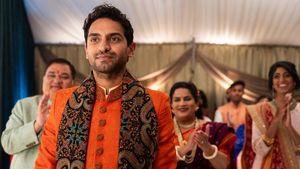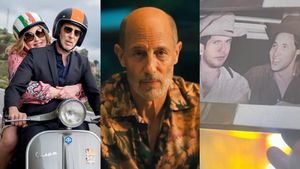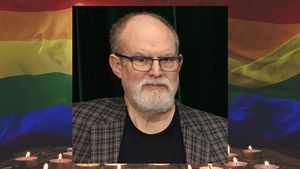If you’ve been to the movies lately, you were far more likely to see a story featuring a superhero, a killer extraterrestrial, or a giant sandworm than someone like me, a happy and healthy person living with HIV. And that’s a huge problem in 2024.
In fact, there were zero portrayals of characters living with HIV out of 256 movies released last year by Hollywood’s leading film distributors, which were tracked by the latest Studio Responsibility Index from GLAAD, the LGBTQ+ media advocacy nonprofit where I work. For the 1.2 million of us with HIV in the U.S., as reported by HIV.gov, this ongoing erasure is unacceptable and harmful.
When Tinseltown does turn the rare camera on this issue, the stories told fall short — to say the least. GLAAD’s 2024 State of HIV Stigma report outlines a dismal recent history of TV and film productions that perpetuate negative, unfair, and outdated ideas and beliefs. You know the tropes: the mass graves; the overflowing hospital wards; the tainted blood transfusions; the threats to expose a character’s HIV-positive status as blackmail; the horror of a diagnosis.
We’ve seen these stories and portrayals. Haven’t we had enough?
I can say from experience that being diagnosed with HIV is terrible — and in the aftermath of the AIDS crisis, stories that depicted these terrors were essential to raising awareness of the pandemic and forcing political, cultural, and societal action. But it may surprise you when I say that I don’t think this is the story we should be telling in 2024.
Looking back, it was never this virus that destroyed my life. It was everyone around me, employing a constant stream of rejection and embarrassment, who made me feel small. People I revered unknowingly distilled my worth to dust in seconds — and most didn’t know any better.
GLAAD’s State of HIV Stigma report found that only 30 percent of Gen Z adults said they feel knowledgeable about HIV; half of Americans overall felt the same. Part of this ignorance is due to a systemic failure of our nation’s schools to teach sexual health for the 21st century. Make no mistake, the renewed far-right push for bans on LGBTQ+ books and coursework also targets HIV education.
Like it or not, it’s largely fallen on Hollywood to shape public perceptions of HIV. And the entertainment industry’s failing grade for realistic depictions of HIV has consequences. HIV.gov estimates that 13 percent of those with HIV don’t know their status and need testing. And media representations steeped in fear, death, and ostracism heighten stigma and misinformation, which can prevent access to care.
If a diagnosis goes unchecked or untreated, the consequences can be dire. For health, this includes a worsening condition, increased risk of recurrence, or more difficult treatment ahead. And we know all too well that Silence = Death. So the time is now, with tools and talent, to fill this acceptance gap and disallow HIV stigma from permeating in ways that keep us clinging to narratives of shame and death.
It’s been a few years now since I disclosed my HIV-positive status in a 2021 essay for Good Morning America, where I used to work. I did so in such a public way in hopes of shedding light on what life is really like for people like me living with HIV. At the time, I had kept my status a secret for almost eight years. As someone who was cultivating LGBTQ+ storytelling as a journalist, I felt I was living a double life, hiding from my own story and experience. I had enough of living that way.
Today, HIV is the most managed thing in my life. It’s remarkable to stop and read that sentence twice over. I live loudly and boldly, in memory of so many who never got lifesaving treatment and care. They never got to live their lives at all.
Knowing that life is a gift — and that I will be living a long and healthy one — is the story I want to tell. The fact that I’m anxious and annoying when I’m in love is the story I want to tell. That I’m a “Disney Gay” in denial and that I call my mom every Sunday at 2 p.m. is the story I want to tell. That I’m living a life and profession I never thought was possible is the story I want to tell. For everyone living with HIV, there is so much more story to tell.
Thanks to modern medicine, that Undetectable = Untransmittable and groundbreaking HIV prevention and innovative treatments like PrEP, stories about HIV in 2024 can and should be very different from the ones we’ve seen before.
I’m challenging Hollywood to uphold a proper standard of care to the audiences it claims to serve, because we know that how we see ourselves in the world impacts how we show up in it. And how we show up in the world collectively has the power to shift culture. It could not be more true about creating authentic, multidimensional portrayals of people living with HIV. In fact, GLAAD research shows that for viewers, seeing these kinds of stories drives up the comfort of interacting with people living with HIV by as much as 15 percent.
Dr. Brené Brown, who studies shame, defines this feeling as “the fear of not being worthy of connection and belonging.” In short, shame prevents worthiness. Stigma has had its hold on people living with and impacted by HIV for long enough. Stories that inspire new attitudes and sentiment around people like me are a true antidote to fear, misinformation, and unworthiness.
It’s time to tell our story — my story — and fully treat HIV stigma for good.
Tony Morrison is GLAAD’s senior director of communications and a 2024 Out100 honoree. @thetonymorrison
From Your Site Articles
Related Articles Around the Web













































































